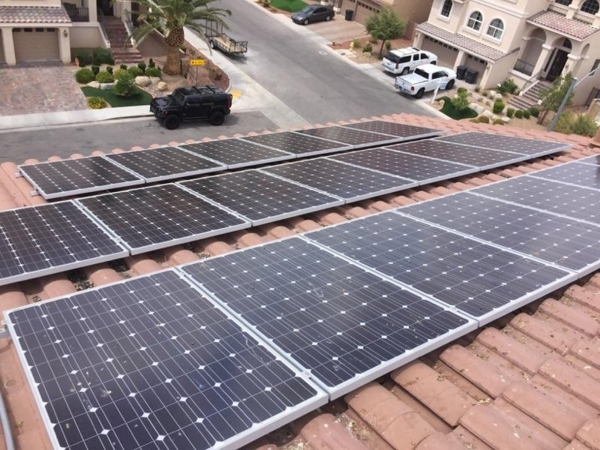
The solar lobby, stung by the state Public Utilities Commission’s decision against extending the net metering cap, is refocusing its efforts on shaping the upcoming debate over the Value of Solar Tariff.
That’s the concept that will determine the price at which solar power can be sold back to the grid and whether solar energy pencils as a good investment for residential and commercial customers.
At its Aug. 12 meeting, the PUC denied a proposal by the solar lobby group to extend current credits for rooftop installations when the state’s net metering cap is reached sometime in September.
At the heart of the issue is NV Energy’s contention that the current residential rooftop solar program is not fair to the non-solar residents who must pay for the infrastructure and capacity to continue to deliver power to solar residents.
The recent passage of Senate Bill 374 shifted responsibility from the Nevada Legislature to the PUC to evaluate what is called the Value of Solar Tariff and establish new guidelines for connecting rooftop solar to the grid. In response, NV Energy has submitted a 500-page filing to the PUC as an update to its view of the net metering rules. The PUC has until Dec. 31 to draft a plan.
While solar enthusiasts are not happy with the elimination of net metering, a Value of Solar Tariff, if properly developed, can be an option that works for the solar customer, the utility and the non-solar utility customers.
The tariff is not a new idea and has proved to be quite successful since it was first adopted by Austin, Texas, in 2006 and by Minnesota in 2014.
There are two basic components to the tariff calculation.
First, the solar customers continue to buy all of their energy from the utility company at the utility’s retail rate, which includes all of the costs of power production, the purchasing of power, and the transmission and distribution of the power.
Second, the solar customers feed 100 percent of their generated power into the grid and are compensated by the utility, based on an established rate in dollars per kilowatt hour. The calculation generates a long-term leveled value rate that is studied annually, based on factors that may include:
• Utility variable costs (fuel and purchased power).
• Utility fixed costs (generation capacity, transmission and distribution).
• Distribution system and transmission line losses.
• Ancillary services (to maintain grid reliability).
• And environmental impacts (the reduction of carbon and other pollutant emissions).
The goal of the calculation is to estimate the total value of a unit of solar energy generated in the distribution grid at or very near the point of consumption, eliminating long distribution charges and limiting transmission line losses for a more efficient method of energy production. The result is a conservative estimate of the cost that the utility would face for a unit for energy with the same character as that generated from a local commercial solar facility.
The residential solar customer becomes a source of power generation for the utility, and the total amount of power generated can be more accurately calculated and relied upon for servicing all of the utility’s customer needs. That is different from the current net metering system in which the solar customers bleed off power for their own needs and then push any excess power — in unknown and inconsistent quantities — into the grid, causing spikes and fluctuations that wreak havoc with the utility’s transmission and distribution equipment.
Under the tariff system, the solar customer is billed for their energy use exactly as all other customers within the utility. But they will have an amount deducted from their monthly bill based on the amount of energy they produced and sold to the utility. One advantage that the tariff system might give to the homeowner is the ability to secure better financing for the installation of their system based upon the long-term projection of income.
One variable on the investment side is that each year, a new tariff would be calculated using current data, and the new resulting rate would be applicable to all customers entering the tariff during the year. Changes such as increased or decreased fuel prices and modified hourly utility load profiles because of higher solar penetration could be incorporated into each new annual calculation.
Of concern is that because the utility buys the solar electricity directly from the solar customer, that customer may be subject to taxes on that income and might be ineligible for the federal investment tax credit on their IRS return. To offset that, any excess credit is carried forward each month until the end of the year, when any remaining balance is erased. This zeroing out may help preserve the status of the net metering calculation as “non-refundable credit” for tax purposes.
Critics of the tariff system say that utilities are being allowed to determine the value of the solar power commodity and that the utilities will not be fair in their evaluation. They liken it to Samsung allowing Apple to manufacture their product and, therefore, control the overhead cost of their competitor.
“When you see the transparent and broad-based methodology that has made the Minnesota VOS tariff so successful and fair, it makes sense for Nevada to at least look at this model for our own state,” said Louise Helton, vice president of 1 Sun Solar. “We feel that the residents of Nevada should be part of the conversation and decision-making process.”
The U.S. Green Building Council of Nevada will give a presentation on the topic Tuesday from 3 to 5 p.m. at the inNEVation Center in Las Vegas at 6795 Edmond St., third floor. Admission is free, but registration is required. To RSVP, call Louise Helton 702-592-5330.
The presentation will be followed by a mixer from 5 to 6 p.m. hosted by Bombard Renewable Energy, SolUp, American Patriot Solar, and Robco Electric.






